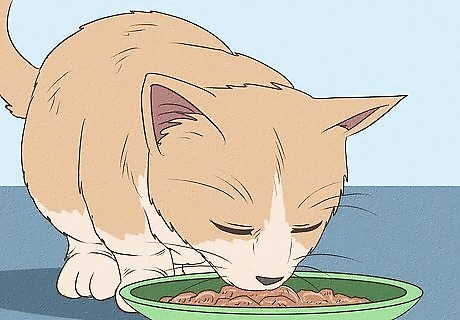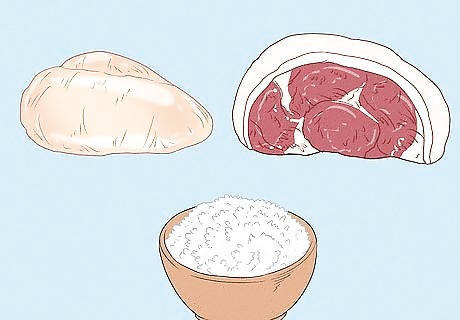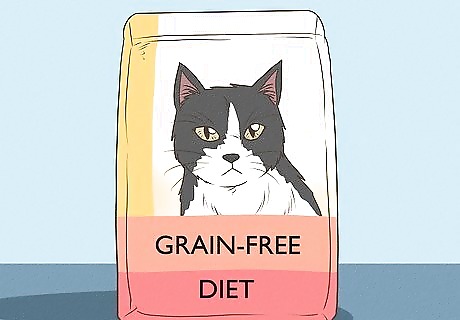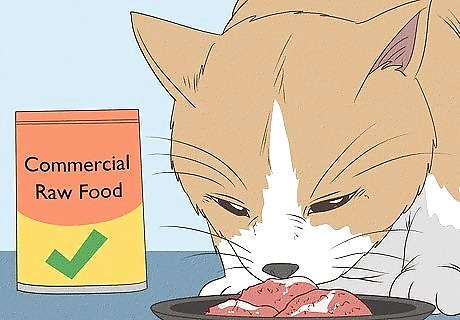
views
X
Research source
Although the exact cause of feline IBD is not known, one potential cause is food allergies. If your vet has diagnosed your cat with IBD, it will be important for you choose the best diet for your cat.
Conducting a Food Elimination Trial

Consult with your vet. A good diet is an important aspect of successfully managing a cat’s IBD. To choose the right diet for your cat, you’ll first need to know what food is causing the problem. While you and your vet discuss dietary options for your cat, they may first recommend a food elimination trial. A food trial will identify the ‘culprit’ ingredient and help you and your vet choose the best long-term diet for your cat. Proteins commonly cause food allergies in cats. Therefore, changing the protein source is often the first step in choosing the right diet for a cat with IBD.

Choose a novel protein diet. Cats are obligate carnivores, meaning they require animal protein sources in their diet. However, some of these proteins, like beef and fish, can cause food allergies that can inflame the GI tract and lead to IBD. Your vet will recommend putting your cat on a diet with a protein your cat has never eaten before (‘novel’ protein). Examples of novel proteins are duck and rabbit. Commercial and prescription novel protein diets are available. Although more expensive, prescription novel protein diets are less likely to contain traces of non-novel animal protein sources. An alternative to novel proteins is hydrolyzed proteins (usually chicken). These proteins are broken down to sizes that are too small for the immune system to detect.

Maintain a strict diet for 6‒8 weeks. During the food trial, your cat can eat only the new diet—no treats, human food, or flavored medication. It can take up to several months for dietary changes to improve IBD symptoms, so you will need to keep your cat on the new diet for at least 6‒8 weeks. Cats do not like switching diets, so make the switch gradually. Mix a small amount of the new diet into the old diet. Then, over the course of at least a week, increase the amount of new diet until your cat is eating only the new diet.

Wait for symptom improvement. With the novel protein diet, your cat’s IBD symptoms should start to improve. If they improve, you will need to ‘re-challenge’ your cat with its old diet to see if the symptoms return. This re-challenging process is needed to confirm which ingredient is upsetting your cat’s GI tract. If your cat’s symptoms don’t improve, your vet may recommend a new food trial with a different type of diet. For example, a low fiber, low fat, easily digestible diet may be good for your cat.
Selecting the Right Diet for Your Cat

Decide which protein to feed your cat. If the food trial identified the ‘culprit’ ingredient as a protein, choose a diet that does not contain that protein. For example, if chicken was the culprit, feed your cat a diet with a novel protein like kangaroo. Keep in mind that, over time, a novel protein will no longer be novel. You may need to keep changing the novel protein source to prevent your cat’s IBD from coming back. If your cat's symptoms improved on the food trial diet, consider keeping your cat on that diet. Even if your cat’s symptoms didn’t improve, your cat will still need an animal protein source in its diet. Choose a different protein that wasn’t in your cat’s old diet or the food trial diet.

Choose an easily digestible diet. When your cat’s GI tract is inflamed from IBD, it will have a hard time digesting and breaking down food. If a novel protein diet didn’t seem to help your cat very much, consider an easily digestible diet. This type of diet contains proteins, carbohydrates, and fat that are easily broken down. Rice is a highly digestible carbohydrate. Low fat diets are usually easily digestible. Some cats with IBD will have less diarrhea with a low-fat diet. Chicken and lamb are high-quality proteins. High-quality foods are usually more digestible than low-quality foods. Talk with your vet if you’re having trouble determining whether a particular diet is digestible.

Determine how much fiber your cat will need. Fiber helps draw water into the GI tract. This will bulk up the feces and make them less watery. If your cat has IBD, extra fiber in the diet can help treat the diarrhea. Be aware, though, that a high-fiber diet does not help all cats with IBD. Dietary fiber comes from plants. Because cats prefer animal protein and fat, your cat may not prefer a high-fiber diet. A low-fiber diet may be better for your cat. Try feeding your cat a high-fiber diet to see if your cat likes it, and if IBD symptoms improve.

Consider whether to feed your cat a grain-free diet. Because cats are obligate carnivores, they do not need carbohydrates in their diet. Although grains have been suggested (and marketed) as sources of feline food allergies, there is not yet scientific data to prove that grains cause food allergies in cats. Examples of grains are rice, corn, and wheat. Because grains are unlikely to inflame your cat’s GI tract, it is not necessary to feed your cat a grain-free diet. However, if you are unsure, your vet can help you determine whether a grain-free diet would be good for your cat.
Choosing a Raw Food Diet

Talk with your vet about raw food diets. A diet for a cat with IBD should be free of additives, preservatives, and coloring agents. However, finding a commercial food, canned or dry, that is free of those ingredients can be difficult. A raw food diet does not contain these ingredients and, therefore, makes a good dietary option for a cat with IBD. Making a homemade raw food diet takes time and require extra attention to ensure complete and balanced nutrition. If you are thinking about making a raw food diet for your cat, talk with your vet or a veterinary nutritionist first. They can provide helpful advice on nutritious raw food diets.

Purchase a commercial raw food diet. If a homemade raw food diet seems like too much work for you, consider purchasing a commercial raw food diet. In addition to saving you time, commercial raw food diets have the advantage of being nutritionally complete. If you would rather prepare the raw food yourself, be aware that transitioning a cat to a homemade raw food diet can take a very long time. Feed your cat a commercial raw food diet first.

Prepare a homemade raw food diet. When preparing a homemade raw food diet, use fresh, high-quality, whole meat (turkey, rabbit, chicken) from your local grocery store or butcher. Avoid buying pre-ground meat, since the ground meat can sit in the display case at the store for a long time and develop bacterial growth. Instead, grind the meat yourself and immediately freeze the portion you're not using. Grinders are available at your local kitchenware store. The store’s staff can show you how to properly operate the grinder. Other than a grinder, you’ll need other kitchen equipment, including meat shears, an electronic scale, and mixing bowls. To make the diet nutritionally complete, you'll need vitamin supplements. Pre-mixed supplements are available that can be added to the meat. Several websites, such as http://www.catinfo.org/?link=makingcatfood#Raw%20vs%20Cooked, have homemade raw food recipes for cats. You can also get recipes from a veterinary nutritionist.




















Comments
0 comment